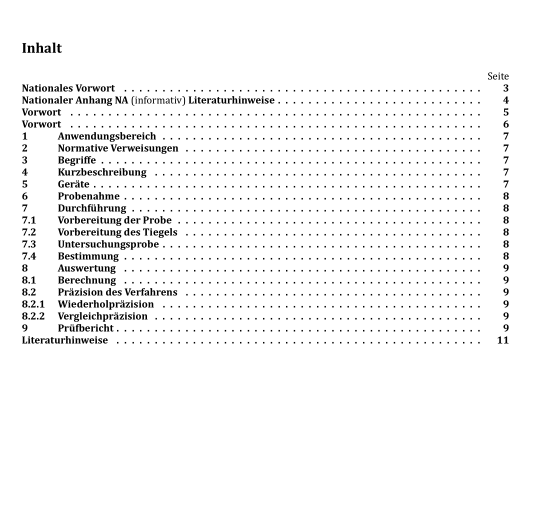DIN ISO 5545:2020 pdf download.Labcaseine und Caseinate – Bestimmung der Asche (Referenzverfahren) (ISO 5545:2008); Text Deutsch und Englisch
This International Standard specifies a reference method for the determination of the ash of caseins obtained by rennet precipitation and of caseinates, with the exception of ammonium caseinate.
NOTE For the determination of ash (“fixed ash”) of acid caseins, of ammonium caseinates, of their mixtures with rennet casein and with caseinates, and of caseins of unknown type, see ISO 5544│ IDF 89
[2] .
2 Normative references
The following referenced documents are indispensable for the application of this document. For dated references, only the edition cited applies. For undated references, the latest edition of the referenced document (including any amendments) applies.
ISO 3310-1, Test sieves — Technical requirements and testing — Part 1: Test sieves of metal wire cloth ISO 5550│ IDF 78, Caseins and caseinates — Determination of moisture content (Reference method)
3 Terms and definitions
For the purposes of this document, the following terms and definitions apply.
3.1 ash of rennet caseins or of caseinates
substances determined by the procedure described in this International Standard
NOTE Ash of rennet caseins or of caseinates is conventionally expressed as a percentage by mass, numerically equivalent to grams per 100 g of product.
4 Principle
A test portion is incinerated at (825 ± 25) °C. The residue is then weighed.
5 Apparatus
Usual laboratory apparatus, and in particular the following.
5.1 Analytical balance, capable of weighing to the nearest 0,000 1 g.
5.2 Silica or platinum dishes, of diameter about 70 mm and of depth 25 mm to 50 mm.
5.3 Electrical furnace, with air circulation, capable of being maintained at (825 ± 25) °C.
5.4 Desiccator, containing an effective desiccant.
5.5 Grinding device, for grinding the laboratory sample, if necessary (see 7.1.4), without development of undue heat and without loss or absorption of moisture. A hammer-mill shall not be used.
5.6 Test sieve, wire cloth, diameter 200 mm, nominal size of aperture 500 µm, with receiver, complying with ISO 3310-1.
6 Sampling
A representative sample should have been sent to the laboratory. It should not have been damaged or changed during transport or storage.
Sampling is not part of the method specified in this International Standard. A recommended sampling method is given in ISO 707|IDF 50[1] .
7 Procedure
7.1 Preparation of the test sample
7.1.1 Thoroughly mix the laboratory sample by repeatedly shaking and inverting the container (if necessary, after having transferred all of the laboratory sample to an airtight container of sufficient capacity to allow this operation to be carried out).
7.1.2 Transfer about 50 g of the thoroughly mixed laboratory sample to the test sieve (5.6).
7.1.3 If the 50 g portion directly passes or almost completely passes the sieve, use for the determination the sample as prepared in 7.1.1.
7.1.4 Otherwise, grind the 50 g portion, using the grinding device (5.5), until it passes the sieve.
Immediately transfer all of the sieved sample to an airtight container of sufficient capacity and mix thoroughly by repeatedly shaking and inverting. During these operations, take precautions to avoid any change in the water content of the product.
7.1.5 After the test sample has been prepared, the determination (7.4) should proceed as soon as possible.
Clean the device after grinding each sample.
7.2 Preparation of the dish
Heat the dish (5.2) in the electrical furnace (5.3), maintained at 825 °C, for 30 min. Allow the dish to cool in the desiccator (5.4) to the temperature of the balance room and weigh to the nearest 0,1 mg.
7.3 Test portion
Weigh, to the nearest 0,1 mg, directly in or by difference approximately 3,000 0 g of the test sample (7.1) into the prepared dishes.
7.4 Determination
Heat the dish containing the test portion on a low flame until the test portion is completely charred, taking care that it does not burst into flame.DIN ISO 5545 pdf download.DIN ISO 5545 pdf download
